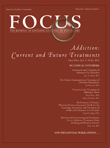Women and Addiction: The Importance of Gender Issues in Substance Abuse Research
Abstract
Substance use was considered to be primarily a male problem, and many substance abuse studies are conducted with a predominance of male participants. However, recent substance abuse research indicates significant gender differences in the substance-related epidemiology, social factors and characteristics, biological responses, progressions to dependence, medical consequences, co-occurring psychiatric disorders, and barriers to treatment entry, retention, and completion. The epidemiology of women's drug use presents challenges separate from those raised by men's drug use. A convergence of evidence suggests that women with substance use disorders are more likely than men to face multiple barriers affecting access and entry to substance abuse treatment. Gender-specific medical problems as a result of the interplay of gender-specific drug use patterns and sex-related risk behaviors create an environment in which women are more vulnerable than men to human immunodeficiency virus. Individual characteristics and treatment approaches can differentially affect outcomes by gender. All of these differences have important clinical, treatment, and research implications.
(Reprinted with permission from Journal of Addictive Diseases 2010; 29:127–138)
Full text of the article available online at http://www.informaworld.com/smpp/title∼db=all∼content=g921472153



